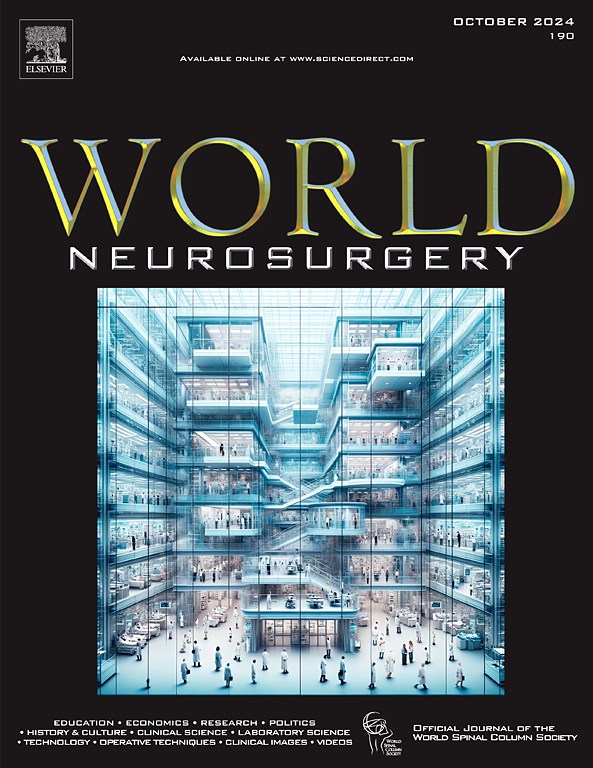胸外科的创新方法:单侧双门静脉内窥镜和3D打印治疗黄韧带骨化。
IF 2.1
4区 医学
Q3 CLINICAL NEUROLOGY
引用次数: 0
摘要
目的:评价单侧双门静脉内镜(UBE)技术联合3D打印技术治疗胸黄韧带骨化(TOLF)所致胸椎管狭窄(TSS)的临床疗效。方法:选取符合手术指征的经影像学诊断为TOLF的患者21例。统计资料包括性别、年龄、影响节段、病因、手术时间、引流量和术后并发症。采用改良的日本骨科协会(JOA)评分评估手术前后的神经功能。术后并发症包括下肢深静脉血栓形成、神经损伤、脑脊液(CSF)泄漏和手术部位感染(SSI)也被记录。影像学研究,包括CT、MRI、椎管截面积和3D打印模型,用于评估脊髓压缩和减压结果。结果:21例患者中,单节段减压15例,双节段减压6例。单节段减压平均手术时间为95分钟,双节段减压平均手术时间为125分钟。单节段平均引流量为48 mL,双节段平均引流量为80 mL。CT、MRI、椎管截面积和3D打印模型显示椎管有效体积显著增加。单纯性TOLF患者术后1年平均恢复率为70±11%,而双节段患者术后1年平均恢复率为57±9.4%。患者中没有下肢深静脉血栓形成、神经损伤或SSI的病例。术后仅有2例患者出现脑脊液漏。结论:UBE技术联合3D打印技术治疗TOLF具有微创、恢复快、疗效明确等优点。这种方法可以显著减轻并发症,如神经系统恶化。本文章由计算机程序翻译,如有差异,请以英文原文为准。
Innovative Approaches in Thoracic Surgery: Unilateral Biportal Endoscopy and 3D Printing in Managing Ligamentum Flavum Ossification
Objective
The objective of this study was to assess the clinical efficacy of unilateral biportal endoscopy technology in conjunction with three-dimensional (3D) printing technology for treating thoracic spinal stenosis caused by thoracic ligamentum flavum ossification (TOLF).
Methods
A total of 21 patients diagnosed with TOLF through imaging who met surgical indications were selected. Demographic data, including sex, age, affected segments, etiological factors, operation duration, drainage volume, and postoperative complications, were documented. The modified Japanese Orthopaedic Association score was used to evaluate neurological function before and after the surgical intervention. Postoperative complications, including lower extremity deep vein thrombosis, neurological injury, cerebrospinal fluid leakage, and surgical site infection, were also recorded. Imaging studies, including computed tomography, magnetic resonance imaging, cross-sectional area of the spinal canal, and 3D printing models, were utilized to evaluate spinal cord compression and decompression outcomes.
Results
Among the 21 patients, 15 underwent single-segment decompression, and 6 underwent double-segment decompression. The average operation time for single-segment decompression was 95 minutes, while double-segment decompression averaged 125 minutes. The average drainage volume was 48 mL for single-segment and 80 mL for double-segment procedures. Computed tomography, magnetic resonance imaging, cross-sectional area of the spinal canal, and 3D-printed models demonstrated a significant increase in the effective volume of the spinal canal. The average recovery rate at 1 year postsurgery for patients with simple TOLF was recorded at 70 ± 11%, while that for double-segment cases was 57 ± 9.4%. There were no instances of lower extremity deep vein thrombosis, neurological injury, or surgical site infection among the patients. Only 2 patients experienced postoperative cerebrospinal fluid leakage.
Conclusions
Unilateral biportal endoscopy technology combined with 3D printing technology offers advantages such as minimal invasiveness, rapid recovery, and definite efficacy in the treatment of TOLF. This approach can significantly mitigate complications such as neurological deterioration.
求助全文
通过发布文献求助,成功后即可免费获取论文全文。
去求助
来源期刊

World neurosurgery
CLINICAL NEUROLOGY-SURGERY
CiteScore
3.90
自引率
15.00%
发文量
1765
审稿时长
47 days
期刊介绍:
World Neurosurgery has an open access mirror journal World Neurosurgery: X, sharing the same aims and scope, editorial team, submission system and rigorous peer review.
The journal''s mission is to:
-To provide a first-class international forum and a 2-way conduit for dialogue that is relevant to neurosurgeons and providers who care for neurosurgery patients. The categories of the exchanged information include clinical and basic science, as well as global information that provide social, political, educational, economic, cultural or societal insights and knowledge that are of significance and relevance to worldwide neurosurgery patient care.
-To act as a primary intellectual catalyst for the stimulation of creativity, the creation of new knowledge, and the enhancement of quality neurosurgical care worldwide.
-To provide a forum for communication that enriches the lives of all neurosurgeons and their colleagues; and, in so doing, enriches the lives of their patients.
Topics to be addressed in World Neurosurgery include: EDUCATION, ECONOMICS, RESEARCH, POLITICS, HISTORY, CULTURE, CLINICAL SCIENCE, LABORATORY SCIENCE, TECHNOLOGY, OPERATIVE TECHNIQUES, CLINICAL IMAGES, VIDEOS
 求助内容:
求助内容: 应助结果提醒方式:
应助结果提醒方式:


